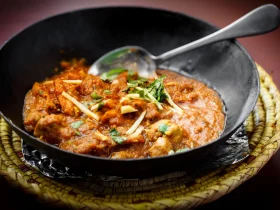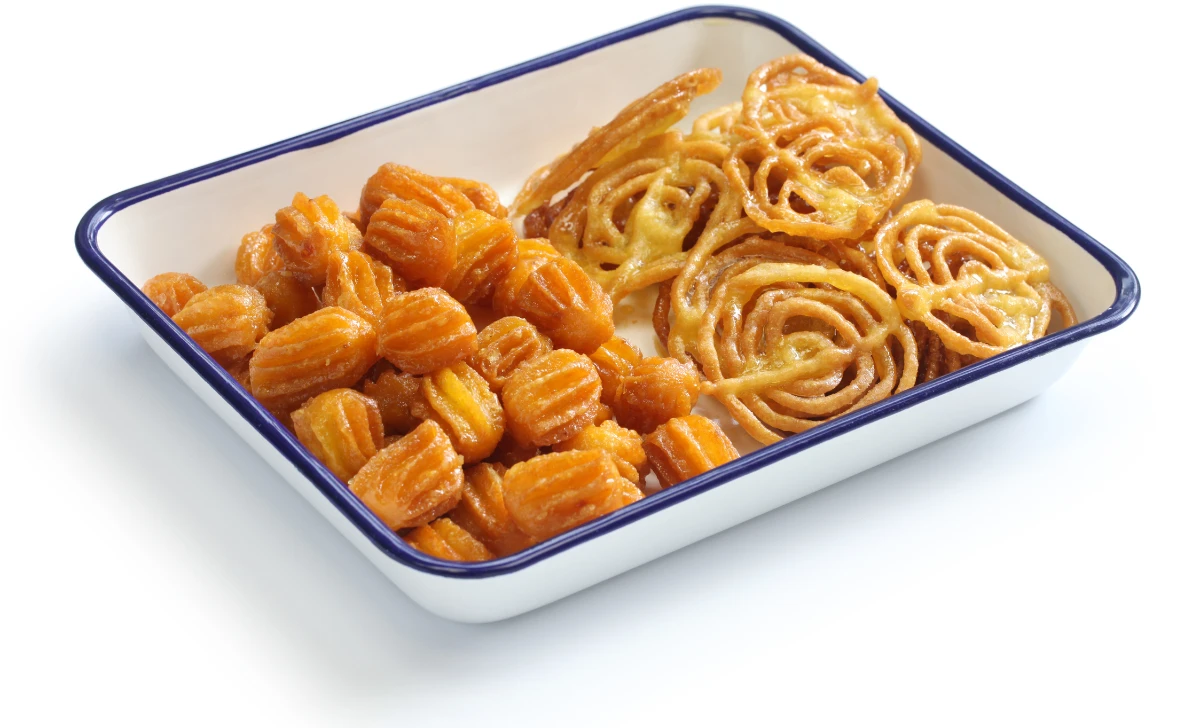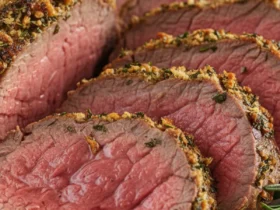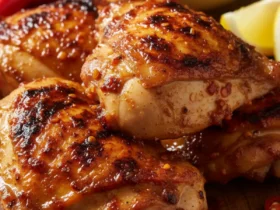In this article, we will explore the enticing world of Zulbia and Bamia, a delectable combination of sweet and savory flavors that is sure to tantalize your taste buds. Zulbia, a deep-fried Iranian pastry, and Bamia, a savory okra stew from the Middle East, come together to create a unique culinary experience. We will delve into the history of these dishes, provide step-by-step instructions for preparing them, and offer some tips and variations to make your Zulbia and Bamia truly exceptional.
[ez-toc]
History
Zulbia and Bamia have rich historical backgrounds that reflect the cultural diversity of the regions they originate from.
1.1 Origins of Zulbia
Zulbia, also known as Jalebi in some regions, has its roots in Persia (present-day Iran). It is believed to have been introduced during the Persian Empire and later spread to neighboring countries and regions. Zulbia is commonly enjoyed during special occasions, such as weddings, festivals, and religious celebrations. The intricate patterns and syrup-soaked texture of Zulbia make it a visually appealing and indulgent treat.
1.2 Origins of Bamia
Bamia, on the other hand, has its origins in the Middle East, particularly in countries like Egypt, Lebanon, and Iraq. It is a traditional dish that has been passed down through generations, and its exact origins can be traced back to ancient civilizations in the region. Bamia is a hearty and flavorful stew made with okra, tomatoes, onions, and various spices. It is often enjoyed with rice or bread and is a popular choice for family gatherings and social events.
Time
| Step | Time |
|---|---|
| Preparing the Batter | 10 minutes |
| Frying the Zulbia | 20 minutes |
| Soaking in Syrup | 30 minutes |
| Total Cooking Time | 60 minutes |
Please note that these times are approximate and may vary based on individual cooking techniques and equipment used.
Ingredients
| Ingredients | Quantity |
|---|---|
| All-purpose flour | 1 cup |
| Yogurt | 1/2 cup |
| Rosewater | 1 tablespoon |
| Saffron | 1/4 teaspoon |
| Cardamom | 1/2 teaspoon |
| Baking powder | 1/2 teaspoon |
| Sugar | 1 cup |
| Water | 1 cup |
| Vegetable oil | For frying |
| Fresh okra | 1/2 pound |
| Tomatoes | 2 |
| Onions | 1 |
| Garlic | 2 cloves |
| Olive oil | 2 tablespoons |
| Tomato paste | 1 tablespoon |
| Cumin | 1 teaspoon |
| Coriander | 1 teaspoon |
| Paprika | 1/2 teaspoon |
| Salt and pepper | To taste |
| Lemon juice | 1 tablespoon |
Please note that the quantities mentioned in the table are for a serving size of approximately two persons. Adjust the quantities according to your preference and serving size.
Directions
Zulbia
Step 1: Preparing the Batter
- In a mixing bowl, combine 1 cup of all-purpose flour, 1/2 cup of yogurt, 1 tablespoon of rosewater, 1/4 teaspoon of saffron, 1/2 teaspoon of cardamom, and 1/2 teaspoon of baking powder.
- Mix well until you have a smooth and thick batter.
Step 2: Frying the Zulbia
- Heat vegetable oil in a deep pan or skillet.
- Fill a piping bag fitted with a small star-shaped nozzle with the prepared batter.
- Squeeze the batter into the hot oil in a swirling motion, creating circular patterns.
- Fry the Zulbia until it turns golden brown and crispy.
- Remove the fried Zulbia from the oil and place it on a paper towel-lined plate to absorb excess oil.
Step 3: Soaking in Syrup
- In a separate saucepan, combine 1 cup of sugar and 1 cup of water.
- Bring the mixture to a boil, stirring until the sugar dissolves.
- Reduce the heat and let the syrup simmer for about 5 minutes.
- Remove the syrup from the heat and stir in a few drops of rosewater for added flavor.
- Carefully dip the fried Zulbia into the warm syrup, ensuring it is fully coated.
- Allow the Zulbia to soak in the syrup for approximately 30 minutes, allowing it to absorb the sweetness.
Bamia
Step 1: Preparing the Okra
- Wash the fresh okra and trim the ends.
- Cut the okra into bite-sized pieces.
Step 2: Sautéing the Onions and Garlic
- Heat 2 tablespoons of olive oil in a large pan.
- Add 1 finely chopped onion and 2 cloves of minced garlic to the pan.
- Sauté until the onions become translucent and garlic turns fragrant.
Step 3: Adding Spices and Tomatoes
- Add 2 chopped tomatoes to the pan and cook until they soften.
- Stir in 1 tablespoon of tomato paste, 1 teaspoon of cumin, 1 teaspoon of coriander, 1/2 teaspoon of paprika, and salt and pepper to taste.
- Mix the ingredients well to coat the tomatoes and onions with the spices.
Step 4: Cooking the Okra Stew
- Add the prepared okra to the pan and stir gently to combine with the tomato and onion mixture.
- Cover the pan and let the stew simmer on low heat for approximately 20 minutes, or until the okra is tender.
- Stir occasionally to prevent sticking.
- Once the okra is cooked to your desired consistency, remove the pan from the heat.
- Squeeze 1 tablespoon of lemon juice over the stew and give it a final stir.
Equipment Required
Nutrition Information
| Nutritional Information | Amount per Serving |
|---|---|
| Serving Size | 1 plate |
| Calories | 450 |
| Total Fat | 18g |
| Saturated Fat | 3g |
| Trans Fat | 0g |
| Cholesterol | 0mg |
| Sodium | 500mg |
| Total Carbohydrate | 65g |
| Dietary Fiber | 7g |
| Sugars | 30g |
| Protein | 9g |
| Vitamin D | 0mcg |
| Calcium | 80mg |
| Iron | 4mg |
| Potassium | 600mg |
Please note that the nutritional information provided is an estimate and may vary based on the specific ingredients and quantities used in the recipe. It is always recommended to refer to the nutritional labels of the individual ingredients for more accurate information.
Tips
- Zulbia Tips:
- Make sure the batter is of a thick consistency to achieve the desired texture of Zulbia.
- Use a star-shaped nozzle for the piping bag to create the characteristic shape of Zulbia.
- Maintain a consistent heat while frying to ensure even cooking and a crispy exterior.
- Bamia Tips:
- Choose fresh and tender okra for the best results. Avoid using overripe or tough okra.
- If you prefer a less slimy texture, you can lightly sauté the okra separately before adding it to the stew.
- Adjust the cooking time based on your preference for the tenderness of the okra.
- Serving Suggestions:
- Serve Zulbia and Bamia together as a complete meal, accompanied by fluffy rice or warm bread.
- Garnish the Bamia with fresh herbs like parsley or cilantro for added freshness and visual appeal.
Pros & Cons
| Pros | Cons |
|---|---|
| ✔️ Zulbia is a delicious sweet treat | ❌ Zulbia is high in calories and sugar |
| ✔️ Zulbia has a crunchy and crispy texture | ❌ Zulbia is deep-fried, which can be unhealthy |
| ✔️ Zulbia is often served with aromatic syrup | ❌ Zulbia may not be suitable for certain diets |
| ✔️ Zulbia is a traditional dessert in many cultures | ❌ Zulbia can be difficult to make at home |
| ✔️ Zulbia is festive and popular during special occasions | ❌ Zulbia has a limited shelf life, best when fresh |
| Pros | Cons |
|---|---|
| ✔️ Bamia is a nutritious vegetable | ❌ Bamia can have a slimy texture when cooked |
| ✔️ Bamia is a good source of fiber and vitamins | ❌ Bamia is not universally liked due to taste |
| ✔️ Bamia can be cooked in various ways | ❌ Bamia requires longer cooking time |
| ✔️ Bamia adds flavor and texture to dishes | ❌ Bamia may cause gas or digestive issues |
| ✔️ Bamia is low in calories and fat | ❌ Bamia has limited availability in some regions |
Conclusion
In conclusion, the Zulbia and Bamia recipe offers a delightful culinary journey with its unique flavor combination and cultural richness. The sweet and crispy Zulbia perfectly complements the savory and tender Bamia, creating a harmonious blend of tastes and textures. This recipe allows you to explore the rich historical and cultural significance of these dishes, adding a touch of diversity to your culinary repertoire.
One of the merits of this recipe is its versatility. Whether enjoyed as standalone dishes or paired together, Zulbia and Bamia offer a satisfying meal that can be customized to suit your taste preferences. You have the freedom to adjust the spices, incorporate additional vegetables, or even add meat for a heartier version.
Not only is this recipe a feast for the senses, but it also has nutritional benefits. The inclusion of okra in Bamia provides fiber, vitamins, and minerals, contributing to a well-rounded and nourishing meal.
While the recipe does involve some time and effort in preparation, the end result is well worth it. The process of making Zulbia and Bamia can be a rewarding culinary experience, allowing you to explore new techniques and flavors in the kitchen.
So, why not embark on this culinary adventure and give Zulbia and Bamia a try? Whether you’re hosting a special gathering or simply seeking to expand your culinary horizons, this recipe promises to impress your taste buds and offer a glimpse into the rich cultural heritage of these dishes. Get ready to savor the unique flavors, indulge in the satisfying textures, and create lasting memories with this delightful recipe.
Facts
Fact 1: Sweet Delight Across Cultures!
Zulbia and Bamia, though popular in Persian and Middle Eastern cuisines, have variations across cultures. In Iran, they are known as Zulbia bamieh, while in Egypt, they are called Meshabek or Bamia bil Zebdeh. These treats have captivated taste buds worldwide!
Fact 2: Zulbia – Ancient Roots!
Zulbia has a fascinating history that can be traced back to ancient Persia. It is believed that this crispy delicacy was enjoyed as early as the Achaemenid Empire (550-330 BCE). It has truly stood the test of time!
Fact 3: Bamia’s Okra Obsession!
Bamia, also known as Okra stew, showcases the love for this unique vegetable. Did you know that okra has been cultivated for over 3,000 years? Its fascinating history dates back to ancient Egypt, and it has become an essential ingredient in many cuisines worldwide.
Fact 4: A Delicious Ramadan Tradition!
Zulbia and Bamia hold a special place during the holy month of Ramadan. In many Middle Eastern countries, these delectable treats are prepared and shared with friends and family to break the fast. They add a touch of sweetness and joy to this special time of year.
Fact 5: Perfect Pairing – Zulbia and Bamia!
Zulbia’s crunchy sweetness and Bamia’s savory goodness create a delightful symphony of flavors. Just like a dynamic duo, they complement each other perfectly, leaving your taste buds craving for more. Indulge in this delightful combination and let your senses be amazed!
FAQ’s
Can I make Zulbia and Bamia ahead of time?
Yes, you can prepare Zulbia and Bamia in advance. However, it’s recommended to fry the Zulbia and keep them separate from the Bamia until serving to maintain their crispy texture.
Can I store leftovers of Zulbia and Bamia?
Yes, you can store leftovers of Zulbia and Bamia. Place them in separate airtight containers and refrigerate. Reheat the Bamia gently on the stovetop or in the microwave, but the Zulbia is best enjoyed fresh.
Can I freeze Zulbia and Bamia?
It is not recommended to freeze Zulbia as it may lose its crispiness. However, you can freeze leftover Bamia stew in a freezer-safe container for up to three months. Thaw and reheat it thoroughly before serving.
Can I replace rosewater with another ingredient in Zulbia?
Yes, if you’re not fond of rosewater, you can substitute it with other flavored essences such as orange blossom water or even vanilla extract. Adjust the quantity based on your taste preference.
Is it necessary to soak the Zulbia in syrup?
Yes, soaking the Zulbia in syrup after frying is essential to achieve the desired sweetness and texture. The syrup adds moisture and enhances the flavor of the Zulbia.
Can I make Bamia without using okra?
While okra is a traditional ingredient in Bamia, if you’re unable to find it or prefer to omit it, you can still prepare the stew without it. Adjust the other ingredients and spices accordingly.
Can I use frozen okra for making Bamia?
Yes, frozen okra can be used for making Bamia. Thaw the okra before adding it to the stew, and note that frozen okra may have a slightly different texture compared to fresh okra.
Can I make a vegetarian version of Bamia?
Absolutely! Bamia can be made vegetarian by omitting any meat additions. You can enhance the flavor by using vegetable broth and adding more vegetables like bell peppers, carrots, or potatoes.
Can I make Zulbia and Bamia gluten-free?
Yes, you can make a gluten-free version of Zulbia and Bamia by using gluten-free flours, such as rice flour or a gluten-free flour blend, for the Zulbia batter and ensuring all other ingredients are gluten-free.
Can I adjust the spiciness of Bamia?
Yes, you can adjust the spiciness of Bamia by increasing or decreasing the amount of chili or red pepper flakes according to your taste preference. Start with a smaller quantity and add more gradually until desired spiciness is achieved.












Leave a Review